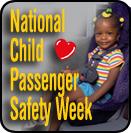National Child Passenger Safety Week
 |
Dear Viewer:
Motor vehicle crashes are the number one killer of children ages 2-14. "The use of belt-positioning booster seats lowers the risk of injury to children in crashes by 59 percent compared to the use of vehicle seat belts." The finding comes from a study of children ages 4 through 7 by Partners for Child Passenger Safety (PCPS), a State Farm-funded research project at The Children's Hospital of Philadelphia.
That’s why The Auto Channel is joining with the National Highway Traffic Safety Administration (NHTSA), the Ad Council and others around Valentine’s Day this year to commemorate National Child Passenger Safety Week (Feb. 13-19). The purpose is to place special emphasis on reminding all parents and other adults responsible for children traveling in motor vehicles: “if they’re are under 4’9”, they need a booster seat.”
While 94 percent of America’s toddlers are now regularly restrained, not enough kids ages 4-8 are properly and safely restrained. Only 10-20 percent of kids ages 4-8 who should be using booster seats to protect them are actually in them. This puts children at an unnecessary risk of being injured or killed in crashes because they are simply in the wrong restraint for their size.
One study showed that children ages 2-5 who are moved to safety belts too early are four times more likely to sustain a serious head injury than those restrained in booster seats. In a traffic crash, the shoulder strap of an adult safety belt will hit a child shorter than 4’ 9”across the neck or face rather than the chest and there is also a greater risk of internal injury because an adult lap belt hits across the child’s stomach rather then his/her lap. These children need a booster seat – which raises them up so that adult safety belts fit over their chests and hips properly – and protects them in the event of a crash.
As children grow, how they sit in your car, truck, van or SUV should also change. For maximum child passenger safety, parents and caregivers simply need to remember and follow the 4 Steps for Kids:
Use rear-facing infant seats in the back seat from birth to at least one year of age and at least 20 pounds;
Use forward-facing toddler seats in the back seat from age one and 20 pounds to about age four and 40 pounds;
Use booster seats in the back seat from about age four to at least age eight – unless the child is 4 ft. 9 inches or taller and
Use safety belts in the back seat at age eight or older or taller than 4 ft. 9 inches. All children age 12 or younger should ride in the back seat.
Many parents are under the false impression that children who have outgrown child safety seats can move right into safety belts, but nothing could be further from the truth. Safety belts, which are designed to fit adults, won’t fully restrain a child in a crash. Using a booster seat will better protect your child from being thrown from the vehicle, or thrown around inside it, during a crash.
Other parents or caregivers may regard booster seats as a hassle to use or a pain to convince their children to use. But truly protecting the ones we love means getting past the temporary complaints and perceived hassles because the lives of our children are really at risk.
So this year at Valentine’s, as we celebrate National Child Passenger Safety Week, please help us remind all parents, grandparents, childcare providers and other adults in charge of children, that if their kids are under 4’9” tall, they need a booster seat.
For more information about the proper use of booster seats, visit www.boosterseat.gov.


